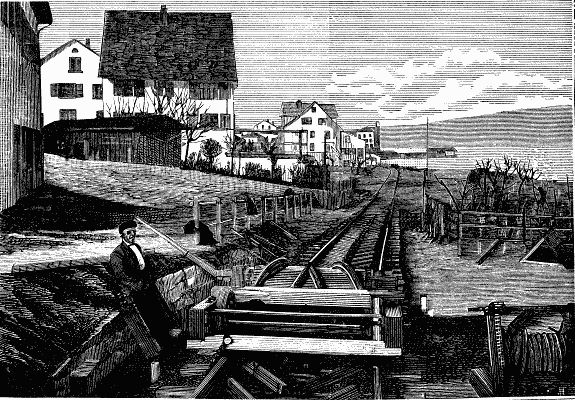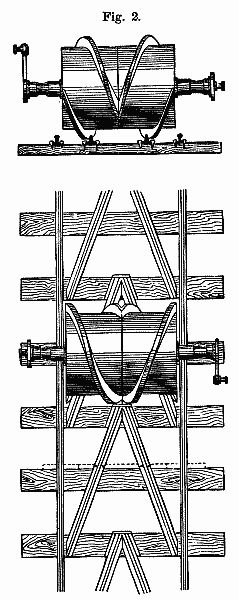Scientific American, Volume XXXVI., No. 8, February 24, 1877 by Various, is part of the HackerNoon Books Series. You can jump to any chapter in this book here. The Wetli Mountain Railroad and Its Disastrous Trial Trip
THE WETLI MOUNTAIN RAILROAD AND ITS DISASTROUS TRIAL TRIP.
Among the various means proposed of late years for building lines of railroad on the steep slopes of mountains, that of M. Wetli, of Zurich, Switzerland, has attracted considerable attention from European engineers. We have already laid before our readers the system of central toothed rails used on the Righi and other mountain roads in Europe. In the Wetli system, instead of this rail and the pinion on the vehicle engaging it, there is a drum having a helicoidal thread which engages with triangular rails. This drum is attached to the locomotive. The construction will be readily understood from the illustrations given herewith, which we take from La Nature. The thread on the drum is precisely that which would be formed could a rail similar to one of the central angular rails be wrapped around it; so that it always is in contact with the mid rails, and necessarily prevents any bodily sliding or rolling of the vehicles over the regular track when the drum is held motionless. The V-shaped mid rails are securely fastened to horizontal iron ties, which rest on wooden traverses. The angle of the V is 50°; the distance between any two traverses is 2.8 feet.

The locomotive has three coupled axles, on the mid one of which the drum is attached so as to be raised or lowered to engage the rails at the will of the engineer: it being possible to cause it to act on the rails with a pressure of 3.7 tons. The diameter of the drum is 2.14 feet. Its spiral thread is of steel, very solidly attached, and so made as to grip the rails to a distance of 0.6 inch below the level of the track. In order to insure this contact, on the drum axle are two pulleys which run on the exterior road, and of which the diameter determines the depth of the hold of the threads. These pulleys are 34.7 inches in diameter, while the driving wheels are very slightly in excess, to provide for the use of tyres.

M. Wetli's invention, as we have described it, was placed between Woedensweil and Einsiedlen, Switzerland. The difference in altitude between these points is 1,513 feet, the distance 9.6 miles. The grade is from 4 to 5 per cent over the first six miles of the way, and subsequently decreases to 1 per cent. The Wetli railroad was established last October only on the heavy grade, that is, the first six miles.
Early in November, trial trips were made which did not prove satisfactory. Sometimes the drum thread gripped the triangular rails properly and acted well; again it would wedge itself upon them, and often would simply roll over their tops without engaging at all. After the first trials, during which very many of the rails were broken, M. Welti re-adjusted the drum thread. Finally, he concluded that he had overcome all difficulties in his apparatus; and accordingly a formal trial was arranged on November 30. For about four and a half miles of the ascent the drum worked well; and the hoarfrost, with which the rails were thickly covered, showed good contact. Afterward it worked irregularly; but the station of Schindelleghi, a distance of five miles, was reached without accident, the locomotive dragging a car loaded with 20 tons of rails. It was then attempted to make the descent by the aid of the helicoidal drum; but this jumped the rails, and broke them almost immediately. By the aid of back pressure of steam and brakes, the locomotive was stopped. Then, unfortunately, the engine was started again; but hardly had the descent been resumed when it was evident that the drum was not holding, and that the speed was accelerating rapidly. Brakes and steam were both found useless, and the engine went tearing over the rails at the rate of a mile a minute. Of the fourteen persons in the vehicles, three were thrown out and killed, and the rest were more or less seriously injured. The heavily loaded car left the track, and tore up both central and side rails until its coupling broke. The engineer, with great intrepidity, clung to his engine, coolly giving signals to open switches so that the locomotive might run upon the level track and so expend its momentum; but the engine left the rails at a sharp curve, destroyed the track for about a hundred feet, and finally stopped a mass of ruins, with its brave engineer mortally wounded. Whether the Wetli system can be made to work as intended by the inventor is regarded as doubtful by the engineers who have examined into the causes of the disaster.
About HackerNoon Book Series: We bring you the most important technical, scientific, and insightful public domain books.
This book is part of the public domain. Various (2006). Scientific American, Volume XXXVI., No. 8, February 24, 1877. Urbana, Illinois: Project Gutenberg. Retrieved https://www.gutenberg.org/cache/epub/19406/pg19406-images.html
This eBook is for the use of anyone anywhere at no cost and with almost no restrictions whatsoever. You may copy it, give it away or re-use it under the terms of the Project Gutenberg License included with this eBook or online at www.gutenberg.org, located at https://www.gutenberg.org/policy/license.html

